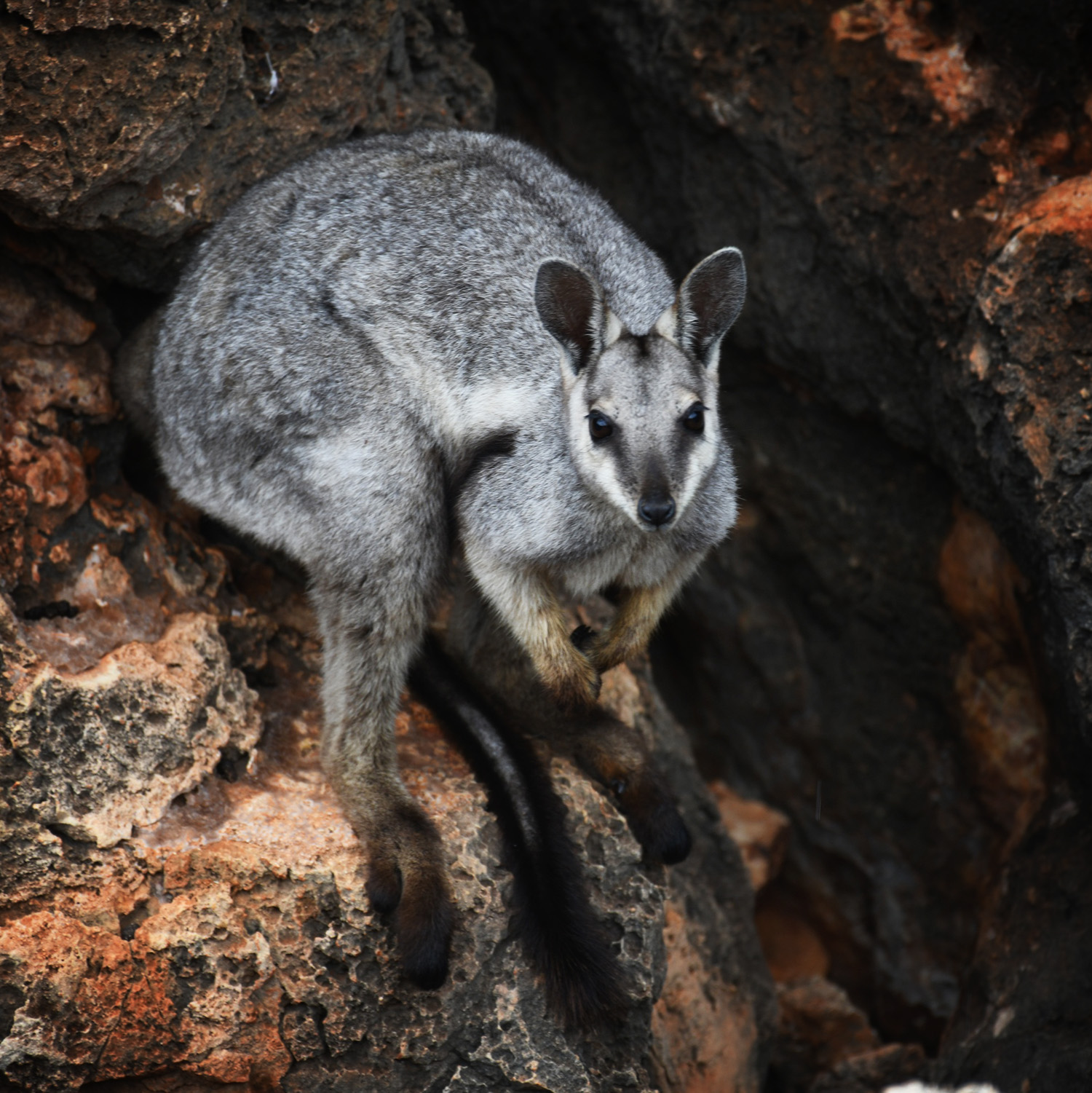We are always conscious that the work we do in land and natural resource management has a direct impact on the wildlife that rely on these habitats to survive.
If you look after and preserve the natural landscape, it makes sense that wildlife will automatically benefit from our efforts. However, some need an extra helping hand, to increase their numbers and improve their survival rate within a now-diminished habitat.
Over the past five years, our Threatened Species ‘Back from the Brink – Stage Two’ project has been undertaking activities with our project partners – the Ellen Brockman Integrated Catchment Group, Australian Wildlife Conservancy, and the Department of Biodiversity, Conservation and Attractions – to support some of our treasured vulnerable and endangered wildlife species including:
- Woylie (Bettongia penicillata ogilbyi)
- Black-flanked Rock-wallaby (Petrogale lateralis lateralis)
- Chuditch (Dasyurus geoffroii)
- Carnaby’s Black Cockatoo (Zanda latirostris)
This has included controlling feral animals over 1972 hectares of critical threatened species habitat; installing and monitoring fifteen nest boxes; revegetating 11.6 hectares of habitat; as well as seed collections to ensure continuation of food supply. Throughout the project, 391 community field days and six training workshops have encouraged the community to learn about the project and its importance to the continuation of the species.
As the project is coming to its five-year milestone, let’s take a closer look at work that has been accomplished for each species.
Woylie (Bettongia penicillata ogilbyi)
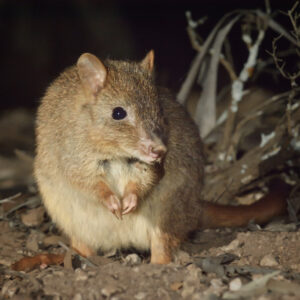 Also known as the brush-tailed bettong, these endangered small nocturnal marsupials only weigh up to 1.8kg with a head-to-tail length of 72cm. Aside from a black-tipped tail their fur is a greyish brown that allows a camouflage amongst the soil and dry grasses while they dig for fungi, tubers, seeds and bulbs. Their tail, which can be half of their total length, is used for balance while moving but is also used to grasp and carry nesting material. Originally widely found across the southern parts of Australia, the introduction of feral predator species of foxes and cats has reduced their population to only four small populations in south-west Western Australia.
Also known as the brush-tailed bettong, these endangered small nocturnal marsupials only weigh up to 1.8kg with a head-to-tail length of 72cm. Aside from a black-tipped tail their fur is a greyish brown that allows a camouflage amongst the soil and dry grasses while they dig for fungi, tubers, seeds and bulbs. Their tail, which can be half of their total length, is used for balance while moving but is also used to grasp and carry nesting material. Originally widely found across the southern parts of Australia, the introduction of feral predator species of foxes and cats has reduced their population to only four small populations in south-west Western Australia.
By partnering with Australian Wildlife Conservancy, we have been able to support actions to help preserve the Woylie for future generations. This has included undertaking eight hectares of revegetation and surveys for weeds and pest animals within 275 hectares of habitat in the Karakamia Wildlife Sanctuary.
If you’d like to see these cute creatures, book a Karakamia spotlight tour with Australian Wildlife Conservancy!
Image: Woylie (Bettongia penicillata ogilbyi) by Australian Wildlife Conservancy
Black-flanked Rock-wallaby (Petrogale lateralis lateralis)
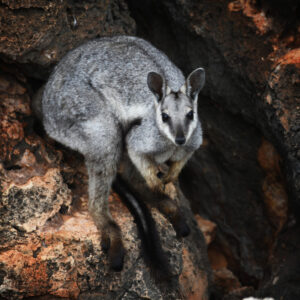 Shy and extremely agile, these pretty little marsupials live amongst rocky outcrops and caves, feeding at dusk and at night on grass, leaves, and fruits. Weighing less than 5kgs and with a head-and-body length of up to 53cm, their longer tail (up to 60cm!) helps them balance as they hop amongst the rocks and sometimes even climb sloping trees. Their rocky habitat and camouflaging colour help them avoid predators including feral foxes and cats, but habitat loss has also contributed to the severe decline in their populations – they are now listed as Endangered.
Shy and extremely agile, these pretty little marsupials live amongst rocky outcrops and caves, feeding at dusk and at night on grass, leaves, and fruits. Weighing less than 5kgs and with a head-and-body length of up to 53cm, their longer tail (up to 60cm!) helps them balance as they hop amongst the rocks and sometimes even climb sloping trees. Their rocky habitat and camouflaging colour help them avoid predators including feral foxes and cats, but habitat loss has also contributed to the severe decline in their populations – they are now listed as Endangered.
By partnering with the Australian Wildlife Conservancy and the Department of Biodiversity, Conservation and Attractions, conservation work has been undertaken at two important habitat sites – Paruna Wildlife Sanctuary and Avon Valley National Park – to protect reintroduced populations of the Black-flanked Rock-wallaby.
Perth NRM have supported regular pest animal control efforts over 1972 hectares combined between the Paruna Wildlife Sanctuary and the neighbouring Avon Valley National Park. Species controlled included the feral predators, foxes and cats, and feral competitors, pigs and goats.
We are proud to be involved and supporting these activities to care for the continuation of the Black-flanked Rock-wallaby.
Image: Black-flanked Rock-wallaby (Petrogale lateralis lateralis) by Stephen Cox / iNaturalist
Chuditch (Dasyurus geoffroii)
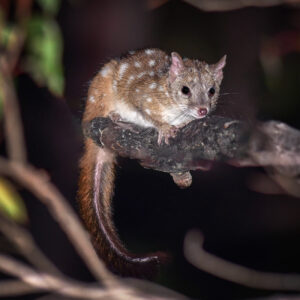 Many people are surprised to learn that the carnivorous Chuditch (Dasyurus geoffroii), also known as the Western Quoll, is a marsupial – with a pouch for carrying it’s young – but unlike many other marsupials, it does not hop. With distinctive white spots against brown fur, they can grow up to 1.3kgs with a total length (head-to-tail) of 75cm – about the size of a domestic cat. While they can be commonly found in trees, they do most of their food foraging on the ground at night with their diet consisting of birds, lizards, frogs, spiders and other large invertebrates. This ground-dwelling habit means they are vulnerable to predation by feral foxes and cats, and have also been impacted by land clearing. They have disappeared from more than 90% of their original distribution across Australia and are listed as a Vulnerable species.
Many people are surprised to learn that the carnivorous Chuditch (Dasyurus geoffroii), also known as the Western Quoll, is a marsupial – with a pouch for carrying it’s young – but unlike many other marsupials, it does not hop. With distinctive white spots against brown fur, they can grow up to 1.3kgs with a total length (head-to-tail) of 75cm – about the size of a domestic cat. While they can be commonly found in trees, they do most of their food foraging on the ground at night with their diet consisting of birds, lizards, frogs, spiders and other large invertebrates. This ground-dwelling habit means they are vulnerable to predation by feral foxes and cats, and have also been impacted by land clearing. They have disappeared from more than 90% of their original distribution across Australia and are listed as a Vulnerable species.
Chuditch have been living successfully at the Australian Wildlife Conservancy’s Paruna Wildlife Sanctuary. To protect this population, our project provided resources to support a comprehensive control program targeted toward eradicating pest predators such as feral foxes and cats across 1952 hectares of land. The project has also resourced over 400 hectares of weed control to protect the ecosystems that the Chuditch rely upon.
Did you know you can visit Paruna Wildlife Sanctuary? Check out the Australian Wildlife Conservancy website for more information.
Image: Chuditch (Dasyurus geoffroii) by pfaucher / iNaturalist
Carnaby’s White-tailed Black Cockatoo (Zanda latirostris)
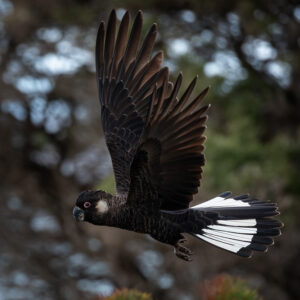 The endangered Carnaby’s White-tailed Black Cockatoo (Zanda latirostris) is one of three black cockatoo species found in south-west Western Australia. While looking similar to the Baudin’s cockatoo, featuring white-coloured feathers and patches on their faces and tails, their beaks are slightly shorter and they are found in regions north of Perth in addition the south-west regions. With an average weight of 650 grams and growing up to 58cm in length, their distinctive call will make you look up to see their one metre wingspan as they fly overhead.
The endangered Carnaby’s White-tailed Black Cockatoo (Zanda latirostris) is one of three black cockatoo species found in south-west Western Australia. While looking similar to the Baudin’s cockatoo, featuring white-coloured feathers and patches on their faces and tails, their beaks are slightly shorter and they are found in regions north of Perth in addition the south-west regions. With an average weight of 650 grams and growing up to 58cm in length, their distinctive call will make you look up to see their one metre wingspan as they fly overhead.
Preferring to eat the seeds and nuts from banksia, hakea, eucalyptus, corymbia and grevillea flora species, they have adapted their diet to include non-native foods to compensate for the loss of their habitat. Land clearing for urban and agricultural development has had the greatest impact on all black cockatoos. This not only reduces their food sources, but the tree hollows they rely on for their nests – hollows of the right size can take more than 100 years to form naturally.
To assist in the preservation of these magnificent parrots, our partnership with Ellen Brockman Integrated Catchment Group has seen the installation of 15 artificial hollows and revegetation of two hectares of preferred fodder species within the north-east region of Perth. There has also been a concerted drive to engage and educate local residents, councils and agricultural landholders in the importance of protecting the Carnaby’s cockatoo.
Image: Carnaby’s White-tailed Black Cockatoo (Zanda latirostris) by michelle__p / iNaturalist
Conclusion
To make sure our native fauna continues to live within its natural environment for future generations, it is important that a collaborative approach is taken. Many people doing consistently focussed work can make a difference, and we are proud of the work that has been completed so far – thanks to the Department of Biodiversity, Conservation and Attractions, Australian Wildlife Conservancy, and the Ellen Brockman Integrated Catchment Group for your support and all the work you do.
For the future, we aim to continue working to support and conserve the amazing wildlife within our region and hope you will join us in our efforts. For more information about our projects, please contact: [email protected]
The Threatened Species program, ‘Back from the Brink Stage Two’, is supported by Perth NRM through funding from the Australian Government’s National Landcare Program.
Article sources
Partners
We acknowledge and appreciate the support of all our partners, supporters, funding bodies and sponsors.

